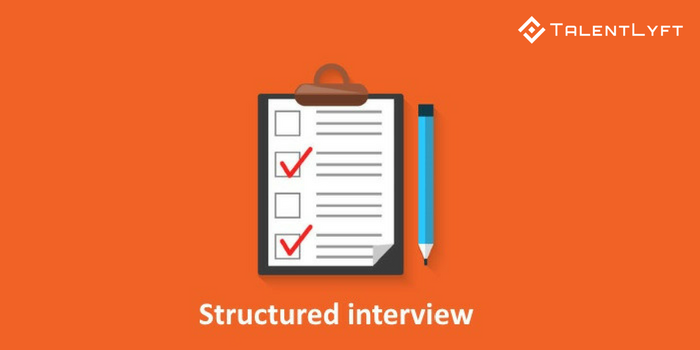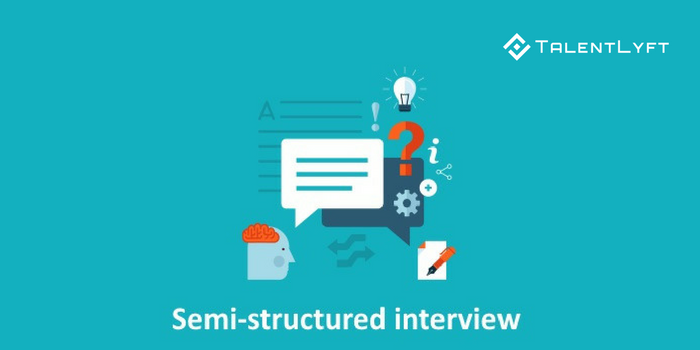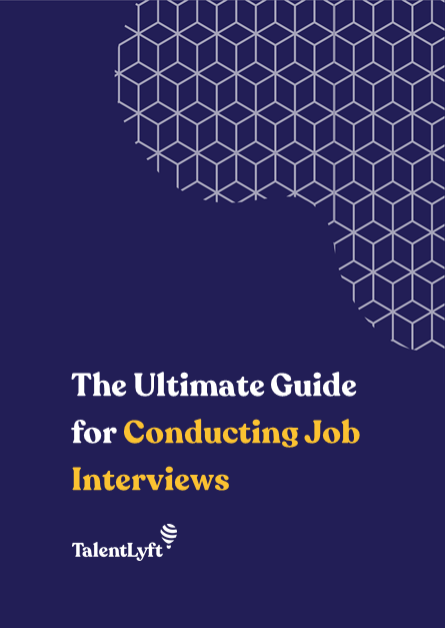![https://adoptoprod.blob.core.windows.net/article/gIwN610YnUK1efeH6_I3Jg.png?7598]()
Job interview types
Before we start, don't forget to download our detailed Guide for Conducting Job Interviews!
A job interview is a formal meeting in which an applicant is asked questions to determine their suitability for a particular job.
Job interviews come in all shapes (face-to-face, phone, or video interview) and sizes (one-on-one, panel, or group interview), but no matter what the format, every job interview can be structured in 3 different ways:
- Structured interviews
- Unstructured interviews
- Semi-structured interviews
What are the differences between these 3 types of job interviews?
Which one should you use to assess candidates?
How to conduct them?
Read on and find out! 🙂

Structured interview definition: What are structured interviews?
A structured interview is a type of interview in which the interviewer asks a particular set of predetermined questions.
In structured interviews, questions are planned and created in advance, which means that all candidates are asked the same questions in the same order.
Structured interviews are also known as:
- Standardized interviews
- Patterned interviews
- Planned interviews
- Formal interviews
Advantages and disadvantages of structured interviews
Advantages of a structured interview
Since in structured interviews, all the candidates are asked the same questions, it’s easy to compare their answers and hire the right job candidate. You can evaluate candidates in the most objective and fair way, which also makes structured interviews more legally defensible.
Disadvantages of a structured interview
On the other hand, structured interviews are harder and more complicated to develop. You have to write them, test them and make sure interviewers stick to them.
You also risk your interview questions leaking out, which means future candidates can come prepared.
Finally, this type of one-size-fits-all interview can seem a bit cold and unpersonalized, making it harder to provide an excellent candidate experience.
How to conduct structured interviews
Keep your interviews structured in 5 simple steps:
1. Develop and write down interview questions to ask candidates.
2. Develop and write down a scale that will be used to grade candidates' answers. (Need an example? Check out Google’s grading rubric for structured interviews.)
3. Print out your questions and bring them with you to the interview site.
4. Take detailed notes of each candidate’s answers.
5. Grade your candidates’ answers according to previously determined scale.

Unstructured interview definition: What are unstructured interviews?
An unstructured interview is a type of interview in which the interviewer asks questions that are not prepared in advance.
In unstructured interviews, questions arise spontaneously in a free-flowing conversation, which means that different candidates are asked different questions.
Unstructured interviews are also known as:
- Informal interviews
- Casual interviews
- Free-flowing interviews
Advantages and disadvantages of unstructured interviews
Advantages of unstructured interviews
The main advantage of an unstructured interview is its personalized approach. This is especially useful when you compare candidates who are equally qualified or for jobs where their personality and communication skills are crucial.
Additionally, since unstructured interviews allow for a free-flowing conversation, they seem much more casual and help candidates relax and feel more comfortable during the interview.
Disadvantages of unstructured interviews
Since in unstructured interviews, different candidates are asked different questions, it’s harder to compare their answers and evaluate candidates equally and objectively.
How to conduct unstructured interviews?
Although unstructured interviews don’t use questions prepared in advance, that doesn’t mean that questions asked in unstructured interviews are totally random.
Here are the most important guidelines for conducting unstructured interviews:
1. Keep in mind the interview’s purpose and the general experiences and qualities you are looking to asses in candidates. Your goal is to gather and record important information about candidates.
2. Make sure you have a focus, but be flexible to proceed based on the candidate’s responses.
3. You can start by asking "tell me about yourself" and then proceed by exploring specific interesting points from your candidate’s resume.

Semi-structured interview definition: What are semi-structured interviews?
A semi-structured interview is a type of interview in which the interviewer asks only a few predetermined questions while the rest of the questions are not planned in advance.
In semi-structured interviews, some questions are predetermined and asked all candidates, while others arise spontaneously in a free-flowing conversation.
Semi-structured interviews are also known as:
- Moderately structured interviews
- Hybrid interviews
- Combined interviews
Advantages and disadvantages of semi-structured interviews
Advantages of semi-structured interviews
Since semi-structured interviews combine both the structured and unstructured interview styles, they can offer the best of both worlds.
They can secure an objective comparison of candidates, but at the same time provide a more personalized and spontaneous approach that allows the exploration of interesting points in a specific candidate’s resume.
Disadvantages of unstructured interviews
Compared with structured interviews, semi-structured interviews are less objective and legally harder to defend.
How to conduct semi-structured interviews?
Here are the most important guidelines for conducting semi-structured interviews:
1. Write down the most important questions that you want to ask all the candidates.
2. Develop a few conversation starters to explore specific interesting points from your candidate’s resume.
3. Depending on your candidates' answers, ask follow-up questions to gain a more in-depth understanding of their qualifications and motivation.
4. Follow the natural flow of conversation and feel free to explore any new job-related topic that arises spontaneously.
Conclusion: Which type of job interview should you use?
Recruiters and human resources professionals divide job interviews into 3 different types: structured, semi-structured and unstructured interviews.
A structured interview is a type of interview in which the interviewer asks a particular set of predetermined questions, while an unstructured interview is a type of interview in which the interviewer asks questions that are not prepared in advance. A semi-structured interview is a hybrid of the previous two types, which means that some questions are predetermined, while others arise spontaneously in a free-flowing conversation.
To determine which type of interview will best suit your hiring needs, start form writing a clear job description (these most common job descriptions templates will help).
Proceed by carefully analyzing job requirements and defining your candidate persona.
Finally, choose the right type of interview based on the needs of your candidate persona.
This approach will help you find and hire your ideal job candidate, improve your candidate experience and make your recruiting efforts more effective and successful.
Get our guide for defining candidate persona!
Take your interviewing strategy to a whole new level!
If you’re looking to make your interviewing strategy even more effective, we can help! 💪
Our TalentLyft Track can make your interviewing process much simpler and more organized.
For starters, you could schedule every interview with just one click! Imagine sending automated emails with an interview appointment that automatically syncs with your work calendar. Cool, huh? 😎
You can also prepare your interview questions and score different candidates’ answers on the spot. Use our existing scorecards to evaluate your candidates, or create your own based on specific job interview questions.
Sounds interesting?
Get in touch with our product specialists who will help you set up a winning interview process!
Schedule a call Frequently asked questions
What are the Differences Between Structured, Unstructured, and Semi-Structured Job Interviews?
Structured job interviews involve a set of predetermined questions asked in the same order for all candidates. Unstructured interviews are more casual, with questions arising spontaneously in a free-flowing conversation. Semi-structured interviews blend both approaches, using some predetermined questions while allowing for spontaneous, conversational elements.
What are the Advantages of Structured Interviews?
The main advantage of structured interviews is their ability to provide an objective and fair way to evaluate candidates. Since all candidates are asked the same questions, their answers can be easily compared. This approach also makes structured interviews more legally defensible.
How Do Unstructured Interviews Benefit the Recruitment Process?
Unstructured interviews benefit the recruitment process by offering a personalized approach. They are particularly useful for roles where personality and communication skills are crucial. The casual nature of these interviews helps candidates relax and be more comfortable, allowing their true personalities to emerge.
What Makes Semi-Structured Interviews Unique?
Semi-structured interviews are unique because they offer the best of both worlds: the objectivity of structured interviews and the personal touch of unstructured interviews. They allow for a standard set of questions for fair comparison while also giving room to explore candidates' specific experiences and qualifications in more depth.
How Should Recruiters Choose Between These Interview Types?
Recruiters should choose between structured, unstructured, and semi-structured interviews based on the specific requirements of the job and the desired candidate persona. The nature of the job, the level of the position, and the cultural fit for the organization should guide the choice of the interview type.



















